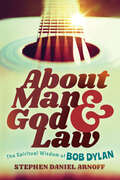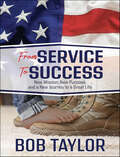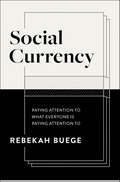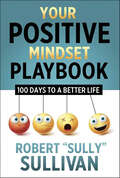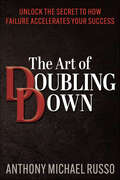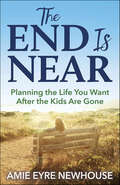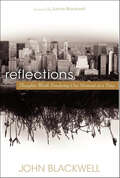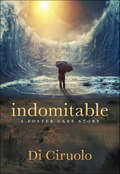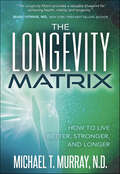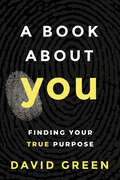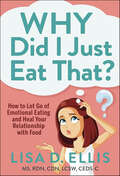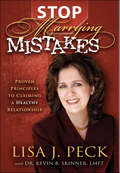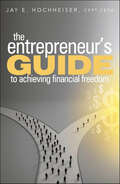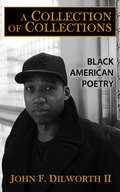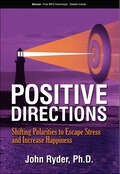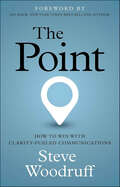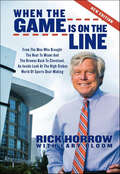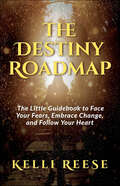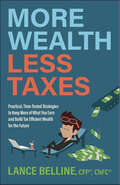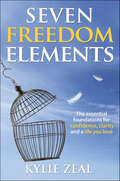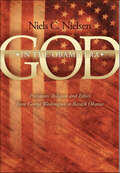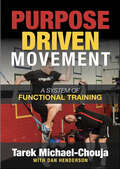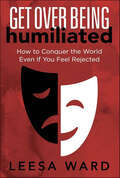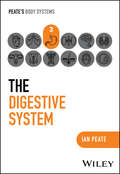- Table View
- List View
About Man and God and Law: The Spiritual Wisdom of Bob Dylan
by Stephen Daniel ArnoffAbout Man and God and Law is the story of how Bob Dylan sparked a revolution of the spirit and why it matters today.Many of our assumptions about empathy, sensual pleasure, and the essence of work, community, country, race, and the divine have germinated in Bob Dylan’s need to know what’s blowing in the wind and how it feels. Tracing his work and vision through themes that have shaped religious and cultural history for millennia, Stephen Daniel Arnoff uncovers how Bob Dylan has re-enchanted ancient questions of meaning and purpose throughout popular culture, inspiring a pantheon of prophetic musicians along the way. This field guide to Dylan's spiritual wisdom aims to make good on the promise that if we look closely enough at his body of work—precisely at a moment when the world we thought we knew seems like uncharted territory—we can open up our eyes to see not only where we really are, but where we need to go.
From Service To Success: New Mission, New Purpose, and a New Journey to a Great Life
by Bob TaylorMore veterans died from suicide in a ten-year period than during the entirety of the Vietnam War There is a very large problem in our veteran community. Every day, 640 veterans attempt suicide, 22 veterans die, and over 5,500 are thinking about committing suicide. Approximately 48% of all military members struggle after transitioning from military service—but these struggles don’t have to be the end of their story. There is a bright and successful future available for every veteran if we can help them reach their greatest potential.From Service to Success is a lifeline for veterans who seek to move past the pain and trauma of service and adapt to a new way of living. A veteran himself, Bob Taylor shares his experiences and the stories of others to remind readers that they are not alone. According to Bob, “We need to find forgiveness for ourselves, find a new purpose, learn new tools and skills, and press forward so we don't spend the rest of our lives in the darkness.”In From Service to Success, Bob Taylor explains that while it's very important for veterans to have the means to support themselves, it is absolutely critical that they learn ways to become a part of their community, to forgive themselves, to develop healthy living styles, and to grab onto the best that life has to offer. The three most important steps for veterans to take after reading From Service to Success:Create a mindset of gratitudeFind a way to sleep through the night—if necessary, seek help to get thereDiscover a purpose bigger than themselves
Social Currency: Paying Attention to What Everyone is Paying Attention to
by Rebekah BuegeMost people waste years of their life, not because they don’t know their purpose, but because their attention is broken, scattered, and sold to the highest bidder without their knowledge.Imagine a day where you’re mentally present, fully focused, and at peace. Even though you’re more productive than usual, you don’t feel rushed or impatient with yourself. You’re protected from distractions, notifications, and thoughts that used to steal your attention away from the moment. Your day feels full, but manageable, because you enjoy most of what’s on your calendar. Days like this are only possible when you start paying attention.Social Currency is an examination of the value of one’s attention, how to protect and invest that attention, practical ways to create a joyful life, and why this matters now more than ever.
Your Positive Mindset Playbook: 100 Days to a Better Life
by Robert SullivanLeading a thriving life takes work—it doesn’t just happen—and daily reflection and affirmations are an essential part of bringing one’s dreams to reality. Your Positive Mindset Playbook is designed to help readers create the life they desire, which begins with what they feed their minds on a daily basis. After writing over 50,000 affirmations of his own, Robert “Sully” Sullivan compiled his top 100, with an application story behind each one. This playbook is for individuals who seek to invest in their future, rather than waiting for their goals to become a reality.An experienced business and military leader, Sully Sullivan knows how reading, writing, and reflection can deepen an individual’s understanding of self and their personal goals and hurdles. He has seen firsthand how a daily practice of examining affirmations and applying them to his life has dramatically improved his mental health and clarity of focus. Sullivan encourages readers to directly engage with the ideas in Your Positive Mindset Playbook. He first directs readers to rewrite the affirmation, which deepens comprehension of the subject and strengthens their memory of it. Then he instructs readers to write what that affirmation means to them personally, which pushes them to connect the ideas to where they are each day. Sullivan hopes that the words within Your Positive Mindset Playbook fill readers’ minds with uplifting thoughts and encouragement that can be easily applied throughout each day.
The Art of Doubling Down: Unlock the Secret to How Failure Accelerates Your Success
by Anthony Michael RussoSuccessful people do not avoid failure, but rather use it as a steppingstone to reach their goals.For too long people have been defeated by the idea that life stops when you fail. In The Art of Doubling Down, authorAnthonyMichael Russoturns this idea on its head, proving that failure is far from the end of the road. The Art of Doubling Down highlights stories of successful people who experienced failure and leveraged it as a learning opportunity to become stronger and more resilient. He also dives into his personal experience growing up with a father who had a gambling addiction that almost destroyed their family, to demonstrate how failure ended up being the key to unlocking success in his own life.Through these inspirational stories and practical tips, individuals can learn how to transform their fear of failure into motivation to face challenges head-on. Theorists will become practitioners who are ready to take on life with a new outlook. And discover how to identify the lesson inside every failure that paves the way towards success in business, life, and finding ultimate happiness.
The End is Near: Planning the Life You Want After the Kids Are Gone
by Amie Eyre NewhouseThe End is Near helps parents find exactly what they want to do with their life once their kids are grown.Amie Eyre Newhouse combines her 24 years as a Registered Nurse helping patients make extraordinarily difficult medical decisions with her personal experience of surviving breast cancer and childhood trauma along with her own journey from full-time parent to empty nester together in order to help parents find their life’s purpose beyond parenting. Throughout The End Is Near, parents learn: The real reasons why they have no idea what to do with themselves once your kids are grown - yet.Five simple steps to turn complex issues into concise solutions.The difference between Hard No’s, Hard Yes’s and Should’s.How to move seamlessly from the role of full-time parent to the role of empty nester.And much, much more!
Reflections: Thoughts Worth Pondering One Moment at a Time
by John BlackwellReflections will not only give you something solid to chew on; it will also feed it to you one bite at a time. Reflections is a short book with a tall agenda: to serve you bite-size ideas that will nourish your soul. Each of these Reflections is a timeless lesson from ordinary experience. In a mere one hundred short pages, you will find wisdom, beauty, goodness, and hope. Reflections will clear your head and show you the next step on your journey. You can read it in one sitting, or you can savor it one page at a time. The choice is yours.
indomitable: a foster care story
by Di CiruoloFrom childhood to motherhood, Di Ciruolo takes readers through very personal and intensely heartbreaking experiences and creates a safe space for trauma survivors with indomitable.Indomitable is a true story of foster care survival. With intentional wit and a healthy amount of self-reflection, Di Ciruolo invites explorers to find the places they can relate to while finding footing on the rungs to healing. Ciruolo shines a light on inner trauma, by offering encouragement and guidance for survivors and those who seek to support them.
The Longevity Matrix: How to Live Better, Stronger, and Longer
by Michael T. MurrayThe Longevity Matrix shares a strategy to help people achieve an extreme level of wellness and vitality.Michael T. Murray, N.D. does not think it is enough to live longer. The desire should be to live better and stronger with a tremendous amount of health, energy, fulfillment, and joy. Dr. Murray believes that if focus is put on accomplishing these goals, then living longer will naturally take care of itself.In naming this book, Dr. Murray chose a descriptive title – The Longevity Matrix. A matrix refers to a set of conditions that provides a system in which something grows or develops. In this context, the “Longevity Matrix” refers to creating the best set of conditions to develop longevity. If that happens, not only will it lead to a longer life, but it also allows the systems within the body and mind to function at the highest possible capacity. Within The Longevity Matrix, Dr. Murray offers a step-by-step approach to improve the function of each body system in order to help people make their health chain as strong as possible by strengthening each individual chain.
A Book About YOU: Finding Your True Purpose
by David GreenA Book About YOU offers a powerful approach for anyone seeking to discover their true self. Within A Book About YOU, David Green describes how different personality types interact with each other and the world around them. His methods help readers to understand their strengths and weaknesses, as well as how to become more understanding of others. With resources to guide readers as they make difficult life decisions, A Book About YOU explains which career path matches an individual’s talents and what major life choice will bring the most fulfillment. This manual for a happier life continues the inner journey of understanding the soul and how to experientially connect with it.
Why Did I Just Eat That?: How to Let Go of Emotional Eating and Heal Your Relationship with Food
by Lisa D. EllisGet off the diet roller coaster and embark on a life-affirming journey towards a positive and sustainable relationship with food and your body.In Why Did I Just Eat That? Registered Dietitian, Certified Eating Disorders Specialist, and food therapist Lisa D. Ellis offers nutritional and therapeutic support in this comprehensive guide to healthy eating. She promotes an all-foods-fit model and mindfulness to explain the connection between human emotions, habits, and physical satisfaction. She rejects the toxic constraints of diet culture and instead encourages self-acceptance, eating intuitively, and fundamentally redefining our relationship with food.Why Did I Just Eat That? begins with removing the blame and shame associated with food by sharing a highly readable overview of how early human survival strategies influence our eating issues today. A self-administered quiz follows, designed to identify the specific types of eating behaviors. Finally, after real case studies and solutions are discussed, Why Did I Just Eat That? provides practical and achievable healing steps tailored to address the needs of each respective type of eater.The science-backed wisdom, exercises, and activities will empower anyone struggling with food to let go of the idea of perfection and define their relationship with food on their own terms, paving the way for deeper self-discovery and a healthier way of living.
Stop Marrying Mistakes: Proven Principles to Claiming a Healthy Relationship
by Lisa J. PeckAfter a divorce, men and women face crucial issues to recover their self-esteem and rebuild their lives. Peck provides an exceptional guide with clear steps to help readers rebuild, strengthen, and enhance their relationships.
The Entrepreneur's Guide to Achieving Financial Freedom
by Jay E. HochheiserThe financial landscape of the business world has changed forever. As a result, it has never been harder to be a successful entrepreneur than it is today. In a world where the entrepreneur must “adapt or die, The Entrepreneur's Guide to Achieving Financial Freedom will guide them toward making the right financial decisions to evolve and thrive—all in a straightforward, no-nonsense manner.
A Collection of Collections: Black American Poetry
by John F Dilworth IIA Collection of Collections is a volume of poetry by John F. Dilworth II that explores the author's experiences maneuvering through life as a young Black man in America in this tumultuous 21st century.Through his poems, John motivates people to be passionate about their purpose and open to sharing their perspective. He captures the beauty and purpose of people hurting and striving. Some of the words may trigger a variety of emotions, but that is where the healing can be found.
Positive Directions: Shifting Polarities to Escape Stress and Increase Happiness
by John RyderHow do you refocus on the positive under any circumstance? Positive Directions is about the specific changes you can easily make that will result in the biggest differences in your life. Dr. Ryder explains how to develop nine psychological skills that empower the individual to conquer problems such as stress, fears, frustrations, misery, lack of energy, sabotaging patterns, and bad decisions. The book simplifies our complex nature and identifies the polar opposites which either swing in the negative (bad) or positive (good) direction. When you are going the wrong way, turn in the opposite - positive direction. This system gives you the knowledge and skills to know how to reverse any negative direction in your life and propel you towards greater success and fulfillment - the positive direction! This book contains a great deal of useful information, fascinating ideas, and fun exercises with helpful tables, graphs, and instructions that can improve your life and relationships.
The Point: How to Win with Clarity-Fueled Communications
by Steve WoodruffIs it possible to grab an audience’s attention in this noisy, confusing world? According to Steven Woodruff, the solution can be summed up in a word: clarity.Clarity-fueled communications is the practice of using the fewest words to make the biggest impact. The Point unveils how the overloaded human brain wants information packaged, and how to craft brain-friendly messages that break through the noise.From email to sales pitches, from workshops to resumes, Steven Woodruff’s Clarity Fuel Formula is the universal recipe for communications success. The Point includes four simple actions and eight compelling shortcuts that can be used by anyone to get to the point and get others on the same page.
When the Game is on the Line: From the Man Who Brought the Heat to Miami and the Browns Back to Cleveland
by Rick HorrowA fascinating insider's look at the people, politics, and power plays behind the mega sports deals. In "When the Game Is on the Line", Rick Horrow reveals the real stories behind the biggest sports deals of the past twenty years, over 100 of which he has brokered. Since early battles with infamous Dolphins owner Joe Robbie and a backstabbing Miami City Commission, Horrow has tangled with colorful figures in sports and government, including NFL Commissioner Paul Tagliabue, Florida Governor Jeb Bush, golf legend Jack Nicklaus, and Miami Heat owner Ted Arison. The results have included new stadiums across America, league expansions, elite teams such as the Miami Heat-- and the bragging rights to go with them. For anyone interested in the high-octane world where sports, business, and politics meet, "When the Game Is on the Line" is a must-read.
The Destiny Roadmap: The Little Guidebook to Face Your Fears, Embrace Change, and Follow Your Heart
by Kelli ReeseMany people have moments when they feel unfulfilled, like they are caught in a life that no longer fits, but how do they know when to stop shoving the discomfort aside and courageously answer the call to do something else? If you’ve stared across the abyss of The Void—that place where one door has closed and another has yet to open—and wondered what's on the other side, The Destiny Roadmap is the way to find out. Career and leadership coach Kelli Reese meets readers where they are and empathically guides them on an adventure to discover where their heart wants to be. The Destiny Roadmap is about a journey of trust and offers manageable tools and techniques, along with an exploration of each individual’s Akashic Records, to create a life in alignment with soul calling. Anyone can co-create the life of their dreams, and The Destiny Roadmap shows you how.
SOS! The Technology Guidebook for Parents of Tweens and Teens: Get the Answers You Need, Keep Them Safe and Enjoy Your Kids Again
by Sheryl GouldSOS! The Technology Guidebook for Parents of Tweens and Teens is Sheryl Gould’s guidebook for parents who seek to keep their children safe online—away from inappropriate content, strangers, and cyberbullying—by equipping them to have the important conversations. With over fifteen years of experience coaching parents and working with families, Sheryl Gould understands how overwhelming and stressful it can be to monitor a child’s internet usage for their safety and mental wellbeing. She created the organization Moms of Tweens and Teens as a way to support parents as they implement effective parenting strategies and reconnect with their children. In SOS! The Technology Guidebook for Parents of Tweens and Teens, Gould’s approach works through common conflicts about screen time as it leads parents away from nagging and arguing with their children and creates more opportunities for “face-to-face time.” In this guidebook, parents will find:Answers to common parenting questions, challenges, and frustrationsSteps to personalize limitations and rules to a child’s needs and development Practical advice for navigating tough conversationsStrategies for getting a child to “buy-in” to screen time limitsPrograms to manage time children spend on devices and content they can access (apps, YoutTube channels, websites, etc.)Suggestions for balance and quality time as a family Restore sanity, get on the same page and rebuild relationship with YOUR tween or teen with SOS! The Technology Guidebook for Parents of Tweens and Teens!
More Wealth, Less Taxes: Practical, Time-Tested Strategies to Keep More of What Your Earn and Build Tax Efficient Wealth for the Future
by Lance BellineWith unique and proven strategies for wealth accumulation, More Wealth, Less Taxes is designed for individuals seeking ways to pay lower taxes during their lifetime—especially during retirement.As a veteran in the financial services industry, Lance Belline knows how essential it is to save strategically and understand how the tax code works. More Wealth, Less Taxes is his guide for anyone who wants to go from “good” to “great” financially. Filled with real-life examples and stories of clients growing their wealth before —and after—they learned of the bucket strategy, Belline’s guide helps individuals gain confidence, peace of mind, and clarity of how they should save and invest. His approach is designed for anyone seeking to learn more about potential tax savings, wealth creation, and financial pitfalls to avoid.
Seven Freedom Elements: The Essential Foundations for Confidence, Clarity and a Life You Love
by Kylie ZealIs it possible to live every day with confidence and clarity while dealing with inevitable life challenges?Absolutely.Seven Freedom Elements makes living a life of freedom simple and helps readers understand the essential foundations they need to move through life’s daily challenges with a sense of confidence and clarity. In the same way that a dream house needs a solid foundation, the ideal life requires a mastering of the essential elements that empower and free those facing life’s challenges to take their next daring step on life’s journey.Whether it is creating a business, generating more money, quality relationships, or simply being happier, it all requires the same foundational, learnable skills. Kylie Zeal has taken all that she has learned through thousands of hours of research, working with clients, and her personal experience, and given structure to those insights. The result is seven key qualities that form the basis of a life of freedom, and Seven Freedom Elements describes them in a way that is easy to read and understand. Readers will discover how old behavior patterns are keeping them stuck, the choices they have over their own self-worth, and how to experience more freedom than they ever believed was possible.
God In The Obama Era: Presidents' Religion and Ethics from George Washington to Barack Obama
by Niels C. NielsenElection 2008 turned out to be a watershed contests, looking to crucial decisions of policy change about the war in Iraq, the international economy, global warming, social security and immigration. God in the Obama Era is written for general readers and is designed to help give objectivity and perspective on debated issues. Its approach is narrative and chronological, not dogmatic. Its premise is that the contemporary presidency stands in a longer historical tradition, which conditions both philosophical, and value judgments. A scholar, who has written in both the history and philosophy of religion, the author is interested in the long term moral values and religious symbols that motivate both voters and public officials. Of course, he is not so naïve as to suppose that truth is always on one side of the election divide. Clearly, the U. S. Constitution guarantees both freedom of worship and the non-establishment of religion. But faith convictions remain a powerful ideological force in American politics.
Purpose Driven Movement: The Ultimate Guide to Functional Training
by Tarek Michael-ChoujaPurpose Driven Movement is a logical, comprehensive and road-tested guide for personal trainers, performance coaches and fitness enthusiasts seeking to understand the world of functional movement and fitness.Tarek Michael-Chouja, owner of the Functional Training Institute, created the Adaptive Functional Training System for those wanting to go deeper into the world of functional training. His approach is the result of years of experience and research compiled by industry experts who have tested and integrated these methods into the real world of fitness.Within Purpose Driven Movement, fitness professionals and enthusiasts will learn how to:Coach with purpose by building a strong coaching vision, mindset and techniqueAssess with purpose by understanding how to detect, correct and prevent poor movement patterns and injuryMove with purpose by progressing through the 5 Pillars of Functional Training, which showcase the key functional movements and toolsProgram with purpose by taking a structured but flexible approach to exercise planning and selection in service of their goalsWhen these four components come together, a great coach is in the making. Anyone seeing to master the art of training and coaching for truly functional fitness will find the answers they seek in Purpose Driven Movement.
Get Over Being Humiliated: How to Conquer the World Even If You Feel Rejected
by Leesa WardGet Over Being Humiliated guides women through the overwhelming and difficult process of returning to the real world when they feel as if they were rejected from it.After experiencing career humiliation in 2006, Leesa Ward embarked on a journey of growth, discovery, and personal development. She discovered that her calling is to help people move on from being humiliated and shamed by their careers. In Get Over Being Humiliated, women learn how to:Practice gratitude and thankfulness as a way of healingCreate the best support system of people who inspire themChange their mindset from one of guilt and self-deprecation to one of empowermentForgive themselves and ask forgiveness from those around themDevelop a vision and direction for the future
The Digestive System (Peate's Body Systems)
by Ian PeatePEATE’S BODY SYSTEMS THE DIGESTIVE SYSTEM A CONCISE, ILLUSTRATED, AND ACCESSIBLE GUIDE TO THE DIGESTIVE SYSTEM Each of the twelve volumes in Peate’s Body Systems series is rooted in the belief that a deep and thorough understanding of the human body is essential for providing the highest standard of care. Offering clear, accessible and up-to-date information on different body systems, this series bridges the gap between complex scientific concepts and practical, everyday applications in health and care settings. This series makes for an invaluable resource for those committed to understanding the intricacies of human biology, physiology and the various systems that sustain life. The Digestive System is the perfect companion for students and newly registered practitioners across nursing and allied health fields with an interest in gastrointestinal care, providing a comprehensive yet easy-to-digest guide for both academic and clinical application. Equips healthcare students and practitioners with the necessary information to provide safe and competent care Features colourful illustrations to aid comprehension, clarify complicated concepts, and render content more engaging and accessible Empowers readers to adapt to a rapidly evolving healthcare landscape, preparing them for the future of healthcare delivery Contains information necessary for effective patient care of those with peptic ulcers, inflammatory bowel disease, and other gastrointestinal diseases and conditions
